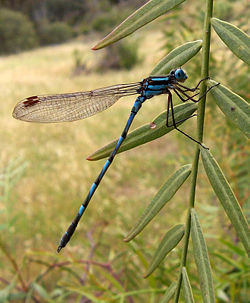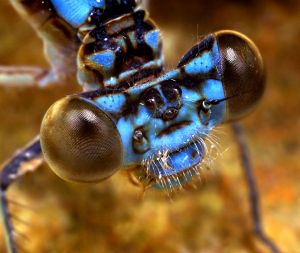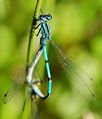Damselfly
| Damselflies | ||||||||||
|---|---|---|---|---|---|---|---|---|---|---|
 Blue Ringtail, Austrolestes annulosus
| ||||||||||
| Scientific classification | ||||||||||
| ||||||||||
|
Amphipterygidae |
The Damselfly (Suborder Zygoptera) is an insect in the Order Odonata. Damselflies are similar to dragonflies, but the adults can be differentiated by the fact that the wings of most damselflies are held along the body when at rest. Furthermore, the hindwing of the damselfly is essentially similar to the forewing, while the hindwing of the dragonfly broadens near the base, caudal to the connecting point at the body. Damselflies are also usually smaller, weaker fliers than dragonflies, and their eyes are separated.
Biology
Damselflies undergo incomplete metamorphosis, with an aquatic nymphal stage. The female lays eggs in water, sometimes in underwater vegetation, or high in trees in bromeliads and other water-filled cavities. Nymphs are carnivorous, feeding on daphnia, mosquito larvae, and various other small aquatic organisms. The gills of damselfly nymphs are large and external, resembling three fins at the end of the abdomen. After moulting several times, the winged adult emerges and eats flies, mosquitoes, and other small insects. Some of the larger tropical species are known to feed on spiders, hovering near the web and simply plucking the spider from its perch.
Gallery
- P1010762-1.jpg
Black Torrent Dart
- P1010464-1.jpg
Coromandel Marsh Dart Ceriagrion coromandelianum
Unidentified damselfly in Victoria, Australia
Mating Damselflies
See also
- Pelecinus a genus of wasp with a similar build to a damselfly.
External links
- American Rubyspot Damselfly Hetaerina americana diagnostic photos and information
- Familiar Bluet Damselfly Enallagma civile
- Emerald Spreadwing Damselfly Lestes dryas
- Stream Bluet Damselfly Enallagma exsulans
- Northern Bluet Enallagma cyathigerum
- Blue-Tailed Damsel, Asian specie.
- Stereoscopic 3d cross eye view, Damsel fly.
Credits
New World Encyclopedia writers and editors rewrote and completed the Wikipedia article in accordance with New World Encyclopedia standards. This article abides by terms of the Creative Commons CC-by-sa 3.0 License (CC-by-sa), which may be used and disseminated with proper attribution. Credit is due under the terms of this license that can reference both the New World Encyclopedia contributors and the selfless volunteer contributors of the Wikimedia Foundation. To cite this article click here for a list of acceptable citing formats.The history of earlier contributions by wikipedians is accessible to researchers here:
The history of this article since it was imported to New World Encyclopedia:
Note: Some restrictions may apply to use of individual images which are separately licensed.















